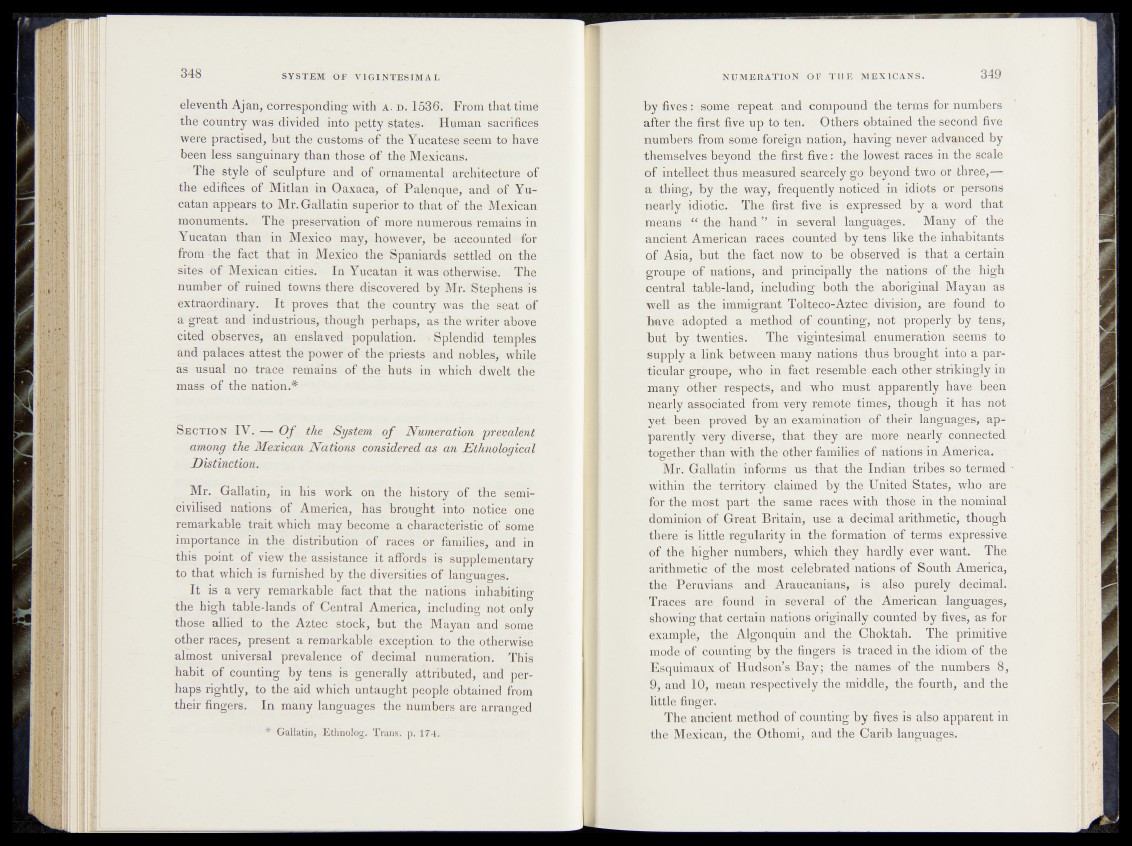
348 SYSTEM OF VIGINTESIMAL
élèventh Ajan, correspbndingwith a. d, 1536v- From that timé
the country was divided into petty states. Human sacrifices
were practised, hat the customs of the Yucatesé seem to have
been less sanguinary than thosWbf the Mexicans.
The style of sculpture and of ornamental architecture of
the edifices of Mitlan in Oaxaca, of Palenqne, and of Yucatan
appears to Mr. Gallatin superior to that of the Mexican
monuments. . The preservation of more numerous remains in
Yucatan than in M exico may,; however, be accounted '■for
from ' the fact that-in Mexico the Spaniards fettled on the
sites of Mexican cities. In Yucatan it was otherwise. The
number of ruined towns there- discovered by Mr^ Stephensfes
extraordinary. It proves that the'countryjvas the seat of
u great and industrious, though perhaps,* as the writer'U.bove
cited observes, an enslaved population. »Splendid temples
and palaces attest the power of thé'priests and nobles,- while
és usual no trace remains of the huts in which dWC^tie
mass of the nation.*
Section IVwr^- O f the System o f Numeration 'prevalent
among the Mexican Nations considered as an Ethnological
Distinction.
Mr. Gallatin, in his work on the history of theffsemi-
civilised nations of America, has brought into ndticq one
remarkable trait which may become a characteristic of some
importance in the distribution of races dr families, and in
this point of view the assistance it affords is supplementary
to that which is furnished by the diversities of - languages.
It is a, very remarkable fact that the nations inhabiting
the high table-lands of Central America,, including not only
those allied to the Aztec stock, but the Mayan and some
other races, present a remarkable exception to the otherwise
almost universal prevalence of decimal numeration. This
habit of counting by tens is generally attributed, and perhaps
rightly, to the aid which untaught people obtained from
their fingers. In many languages the numbers are arranged
* Gallatin, Ethnolog. Trans, p. 174,
NUMERATION OF Til F. MEXICANS. 349
by fivesF some repeat and -compound - .the terms for numbers
after the first five up to ten. Others obtained the second five
numbers from some foreign nation, having never advanced by
themselves beyond the first five.: the lowest races in the scale
of intellect thus measured, scarcely-^‘beyond two or three,—f.
a thing, by the way,, frequently noticed*'in idiots or persons
nearly, idiotic!^ The first, five? is , expressed by, a word that
means1 “ the hand” -in several lan g u ag e Many of the
ancient American races- counted by tens - like! the inhabitants
of Asia, but the fact now to bebobserved is that a certain
groupe of natrons, and principally the. nations jj of the high
central table-land, including both the$ aboriginal Mayan as
well: as the immigrant Tolteco-Aztec division, are found to
havef ad b ^n ifn method of mounting, not properly by- tens,
but by twenties^ The vigintesimal enumeration Seiems to
^Stttpply a link between, many nations thiiA .brought into a particular
grbupe, who in faefc.;resem1§fe each other strikingly in
'many other respects, and who must! apparently have been
nearly associated from very remote times, though it has not
i.yet been proved by an examination of their, languages/; ap- .
parently very diverse, that they are imoifel nearly connected
together than with the other families'of nations in American r *
Mr. Gallatin informs Us that the Indian tribes so termed •
within the territory claimed by the Whited States, who are
for the most part- the same races with^ those in the nominal
dominion of Great Britain, use a decimal arithmetic, though
fherd is little regularity ib- the formation; bf. terms expressive
of the higher numbers, which they hardly ever want. The
arithmetic, of the most celebrated nations of South America,
the Peruvians and Araucanians, ■ is , also purely' decimal.
Traces are found in several of the American languages,
showing that certain, nations originallyhoUntedf by fives, as for
example, the Algonquin and the Choktah. The primitive
mode of counting by the fingers is traced in the idiom of’ the
Esquimaux of Hudipn’s Bay; the names^of .the numbers 8,
9, and 10, mean respectively the middle, the fourth, and the
little finger.
The ancient method of counting by fives is'also apparent in
the Mexican, the Otbomi, and jtheCarib -languages.